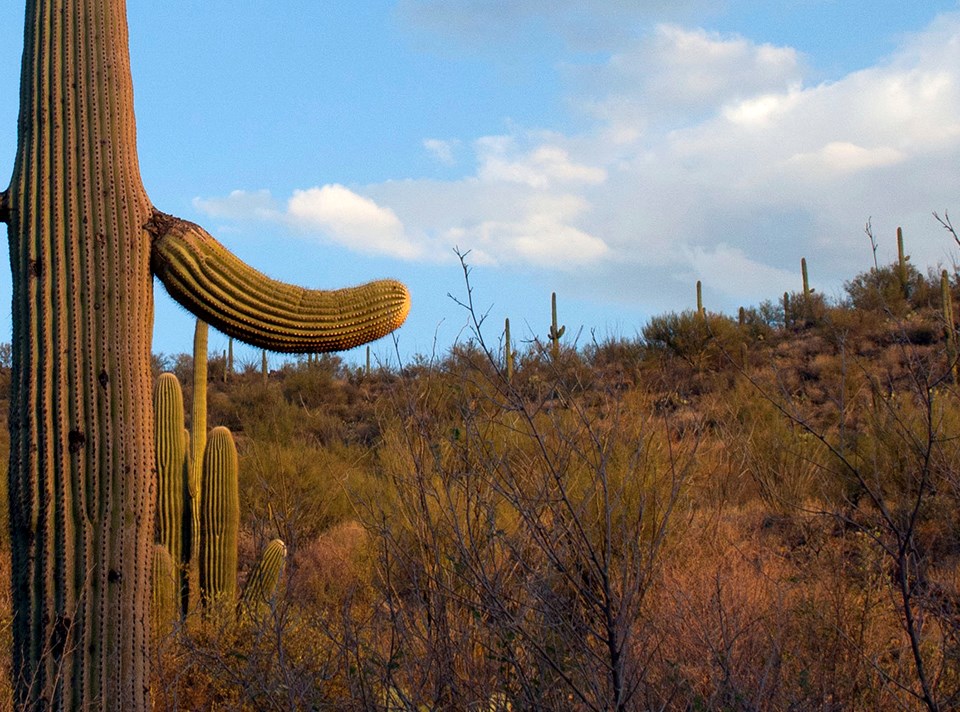Last updated: October 5, 2022
Article
Protecting and Restoring the Sonoran Desert Ecosystem in Saguaro National Park

NPS/T EDGAR
The survival of Saguaro National Park’s namesake, the Saguaro cactus, is threatened by invasive buffelgrass. As a fire-tolerant plant, buffelgrass is not only threatening native species but also propelling more frequent, intense wildfires.
The ability of buffelgrass to spread quickly—doubling in abundance every three to seven years—is transforming the Saguaro’s native desert thornscrub into grass prairie. This transformation can lead to significant increases in the intensity and frequency of fires.
Many plants and animals in the Sonoran Desert did not evolve with wildfire. Native plants can take decades to recover from even mild fires, which can further increase the rate at which buffelgrass spreads.
In Saguaro National Park, buffelgrass is such a strong competitor that no native plant has been able to successfully compete with it. In one area of the park where it has yet to be addressed, buffelgrass doubled from 2012 to 2019. Over that period, multiple infestations totaling about 185 acres expanded, coalescing into one large swath covering almost 800 acres.

NPS
Although a wildfire has not yet burned in buffelgrass in Saguaro National Park, it is just a matter of time. Nearby lands have experienced multiple fires involving buffelgrass, including along roadways, on private lots across the Tucson basin, and in the Santa Catalina Mountains.
Modeling by the U.S. Geological Survey and research in the area show that buffelgrass can convert the Sonoran Desert into a grass-dominated ecosystem, leading to wildfires that would be catastrophic to native plant and animal species.
While Saguaro National Park has implemented buffelgrass control efforts in recent years, more work is needed to control this threat. With additional funding provided through the historic Bipartisan Infrastructure Law, the park is expanding its successful invasive treatments.
The park is using Bipartisan Infrastructure Law funding to treat new infestations before large quantities of seed spread downslope to form additional colonies.
A helicopter with a spot sprayer will be used to clean up small areas that the widespread treatments miss, such as under rock faces or small colonies that often surround large buffelgrass patches. This spot spraying will increase the effectiveness and longevity of widespread treatments.
Other invasive control techniques used at the park cannot reach the higher, rougher, more remote sites where buffelgrass is encroaching. With Bipartisan Infrastructure Law funding, Saguaro National Park has established a strike team of invasive species experts from the local nonprofit Tucson Audubon Society. They are trained and experienced in identification of all significant invasive species. The team members are acclimated and can climb into these areas to find and treat new colonies of buffelgrass.
This investment is part of $103 million of Bipartisan Infrastructure Law funding that the Interior Department allocated earlier this year to reduce wildfire risk, mitigate impacts, and rehabilitate burned areas. During a visit to Saguaro National Park in September, Deputy Secretary of the Interior Tommy Beaudreau announced that over $10 million of the funding is being invested in Arizona to support fuel management projects on nearly 10,000 acres. That funding includes $200,000 for the buffelgrass treatments at Saguaro National Park.
Treating buffelgrass sooner rather than later will reduce the overall cost of treating this invasive species in the long term. Preventing a desert ecosystem from disappearing will not only preserve native species but also reduce wildfire activity and save considerable fire suppression and rehabilitation costs in the future. By enabling Saguaro National Park to increase the use of proven invasive treatment techniques, the Bipartisan Infrastructure Law is helping to restore the Sonoran Desert ecosystem and reduce the threat of wildfires.
